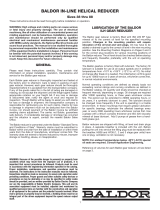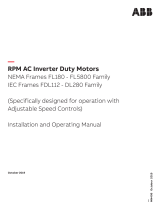Page is loading ...

1
WARNING To insure that drive is not unexpectedly started,
turn off and lock out or tag power source before proceeding.
Failure to observe these precautions could result in bodily
injury.
INSTALLATION:
Shaft Preparation: The bearing journal should not be
exposed to grease, oils or dirt to ensure good life of the
bearing. NO OIL OR GREASE SHOULD BE USED ON THE
INSERT OR SHAFT WHEN ASSEMBLING THIS BEARING.
The shaft should be clean and free of burrs and nicks. The
shaft should be held to a minimum amount of taper and
as little eccentricity as possible so a uniformly distributed
rubbing surface can be maintained. Commercial shafting
tolerance is acceptable, +0.000/-0.002; however, for best
results, the shaft nish should be held to a10 to 20 micro-
inches, and hardness should be 35 Rockwell “C” or higher
(.25 or .50 micro-meters in metric units.)
DODGE collars are available for shaft location, and should
be purchased separately.
WARNING Because of the possible danger to person(s) or
property from accidents which may result from the improper
use of products, it is important that correct procedures be
followed. Products must be used in accordance with the
engineering information specified in the catalog. Proper
installation, maintenance and operation procedures must
be observed. The instructions in the instruction manuals
must be followed. Inspections should be made as necessary
to assure safe operation under prevailing conditions. Proper
guards and other suitable safety devices or procedures as
may be desirable or as may be specified in safety codes
should be provided, and are neither provided by Baldor
Electric nor are the responsibility of Baldor Electric. This unit
and its associated equipment must be installed, adjusted
and maintained by qualified personnel who are familiar
with the construction and operation of all equipment in
the system and the potential hazards involved. When risk
to persons or property may be involved, a holding device
must be an integral part of the driven equipment beyond the
speed reducer output shaft.
Instruction Manual for DODGE
Polymer Sleeve with Polymer Housing
These instructions must be read thoroughly before installing or operating this product.
Assembly: Slide the assembled pillow block on the
shaft. The bearing outer ring OD is spherical and swivels
in the housing to accommodate misalignment. Snug hold-
down bolts and use shaft to swivel each bearing until its
nal position is in the center of free movement top to bot-
tom as well as side to side. This will prevent preloading of
the bearing. Flat washers should be used with hold-down
bolts.
Shim mounting surfaces for full housing contact and verti-
cal shaft adjustment-tighten hold-down bolts to proper
torque.
NOTE: Housing slippage depends on the mounting hold-
down bolt tightening torque, number of bolts and friction
characteristics between mounting surfaces. Auxiliary load
carrying devices such as shear bars are advisable for side
or end loading of pillow blocks and radial loads for ange
units where normal to heavy loading or shock loading is
encountered.
Running In: To imporve life expentancy from this type
of bearing a brief run-in or break-in should be performed.
The break-in should be run with a bearing mounted on
its mating shaft, as in service with all possible loading
removed. The break-in period will build up the lm of solid
lubricant on the shaft to reduce potential start-up damage
to the insert.
OPERATION
The polymer insert contains an impregnated lubricant
that will transfer a lm or coating to the shaft as the shaft
rotates. The lubricant will not squeeze out when the shaft
is not rotating. The lubricant that is impregnagted into the
bushing material is transferred or “worn” onto the rotating
shaft at a rate determined by the rubbing speed of one
material to the other and the imposed load. Since this is a
“wear type bushing”, wear will result under normal operat-
ing conditions.
Operating Temperature Range: -40º to 180ºF (-40º to
82ºC)
Due to unknown loads on take-ups, polymer sleeve bear-
ings are not recommended for use as a take-up bearing.

World Headquarters
P.O. Box 2400, Fort Smith, AR 72902-2400 U.S.A., Ph: (1) 479.646.4711, Fax (1) 479.648.5792, International Fax (1) 479.648.5895
Dodge Product Support
6040 Ponders Court, Greenville, SC 29615-4617 U.S.A., Ph: (1) 864.297.4800, Fax: (1) 864.281.2433
www.baldor.com
© Baldor Electric Company
MN3048 (Replaces 499728)
All Rights Reserved. Printed in USA.
10/10 Printshop 3000
Table 1 - REPLACEMENT PARTS FOR DODGE MOUNTED POLYMER HOUSED SLEEVE BEARINGS
Series 204 205 206 207
Shaft Dia. 20mm 3/4 in 25mm 1 in 30mm 1-3/16 in 1-1/4 in 35mm 1-1/4 in 1-7/16 in
Insert 032868 032867 032871 032872 032874 032875 032876 032878 032877 032879
Pillow Block 034748 034700 034749 034701 034750 034702 034703 034751 034704 034705
2-Bolt Flange 034766 034726 034767 034727 034768 034728 034729 034769 034730 034731
4-Bolt Flange 034759 034716 034760 034717 034761 034718 034719 034762 034720 034721
Tapped Base Pillow
Block
034755 034710 034756 034711 034757 034712 034713 034758 034714 034715
3-Bolt Flange Bracket 034773 034736 034774 034737 034775 034738 034739 034776 034740 034741
Plug 034636
Series 206 210
Shaft Dia 40mm 1-1/2 in 50mm 1-15/16 in
Insert 032882 032881 032887 032886
Pillow Block 034752 034706 034754 034709
2-Bolt Flange 034770 034732 034772 034735
4-Bolt Flange 034763 034722 034765 034725
Plug 034636
Table 2 - MOUNTING BOLT TORQUE VALUES FOR POLYMER HOUSED BEARINGS
2-Bolt Pillow Block Tapped-Base PR 2-Bolt Flange 4-Bolt Flange Flange Bracket
Bearing
Series
Bolt Size Grade 2 Bolt Size
Grade 2
Torque
Bolt Size
Grade 2
Torque
Bolt Size
Grade 2
Torque
Bolt Size
Grade 2
Torque
inch,
mm
in-lbs,
N-m
inch, mm
in-lbs,
N-m
inch,
mm
in-lbs,
N-m
inch,
mm
in-lbs,
N-m
inch,
mm
in-lbs,
N-m
204 3/8, 10 225, 25 3/8-16, M10 x 1.5 225, 25 3/8, 10 200, 22 3/8, 10 200, 22 3/8, 10 200, 22
205 3/8, 10 225, 25 3/8-16, M10 x 1.5 250, 30 3/8, 10 225, 25 3/8, 10 225, 25 3/8, 10 225, 25
206 1/2, 12 300, 30 7/16-14, M10 x 1.5 300, 35 3/8, 10 250, 30 3/8, 10 250, 30 3/8, 10 250, 30
207 1/2, 12 325, 35 1/2-13, M2 x 1.75 400, 45 1/2, 12 300, 35 1/2, 12 300, 35 1/2, 12 300, 35
208 1/2, 12 400, 45 1/2, 12 400,45 1/2, 12 400, 45
209 1/2, 12 450, 50 9/16, 14 450, 50 9/16, 14 450, 50
210 5/8, 16 500, 56 5/8, 16 500, 55 5/8, 16 500, 55
*3048-1010*
/

